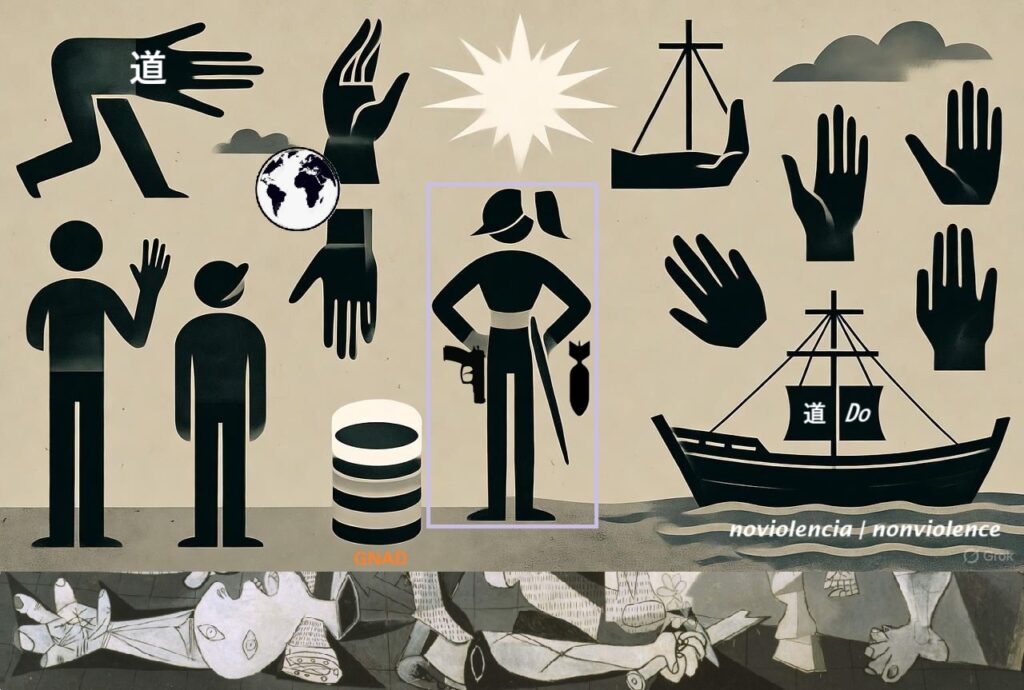It could start like this:
“Now the heated discussion about the flotilla has died down, and everyone is comfortably back home. I recommend checking this article out. It expresses much more beautifully my issues and concerns about how we use the term nonviolence.”
In light of the Sumud Global Flotilla (the most ambitious attempt towards Gaza since Oct-2023), it makes sense to question the real power of unarmed resistance in the face of overwhelming force. Beyond the specific act, whose humanitarian value is unquestionable, this journey is a potent symbol of a tradition that underpins it: active nonviolence. This is not just a tactic, but an ‘intelligence of connection’ that, as the participants demonstrated when facing adversity, seeks to disarm oppressive power not with force, but with unshakable moral firmness. This article is a meditation on that strength.
The opening doubt or phrase is not mine, but it essentially says (as I understand it): «‘Now that the heated discussion about the flotilla has subsided and everyone has comfortably returned home…, a question remains hanging in the air.’ In this post-debate silence, I recall the sharp reflection of a fellow Editor (which he shared with all of us on purpose), whose words resonate strongly with me: the core issue is not the tactic, but the meaning. ‘What does “nonviolence” or “non-violence” really mean? And what, in contrast, is active nonviolence’—that word written without a hyphen—’which marks the difference from a simple strategical or tactical gesture to a way of being in the world?’» Our dear colleague lays down a profound challenge to embark on an inward journey—one we, as Editors and Authors, often intellectually acknowledge yet from which our daily tasks can strangely alienate us.
First, the recent Sumud Global Flotilla, with its purpose of bringing aid and hope to Gaza, had a profound value. Even though it did not physically achieve its goal and was ultimately crushed or hijacked from international waters, with its activists held in a sinister anti-terrorist prison, it was important for the echo it awakened. It was loud, for the attention it drew to a silenced tragedy, and for what it meant as an experience of shared action. Many of its participants lived something essential on that journey: the fragility and the strength of determination found in acting together. I am because we are. The sense of being and engaging in “something with purpose,” of feeling part of a living current that acts for human dignity.
That experience—beyond visible success or media results—embodies the very root of active nonviolence: the certainty that there are acts measured not by what they achieve, but by what they awaken. The media, concentrated in the hands of those complicit in what is happening in Gaza and in Israel/Palestine in general since 1900 onwards, will ensure it is soon forgotten, and will even delete pages and content referencing the fact that the flotilla existed, that it set sail…
An Archive That Restores Faith in Human Action
It was thanks to that reflection from my fellow Editor at Pressenza and a link that I found the article Can Nonviolent Struggle Defeat a Dictator?, published in Portside, which presents the Global Nonviolent Action Database (GNAD) created at Swarthmore College under the direction of George Lakey.
I was surprised, both by the “Portside” website and its contents, and by the GNAD database. Very much so. The reading and the full text offer an emphatic answer: yes, nonviolent struggle can defeat dictators. And it demonstrates this with evidence: over fourteen hundred documented campaigns in a hundred countries, at least forty of them culminating in the fall of authoritarian regimes.
GNAD is not just a database: it is a moral archive of Humanity, an active memory of what collective dignity can achieve without resorting to destruction.
Its value is multiple. It preserves the history of those who refused to replicate violence; who refused to further chain themselves to violence by responding with violence (the same or another); it teaches concrete strategies of resistance; it legitimizes active nonviolence as a rigorous and effective field of study; and it inspires new forms of action. It reminds us that a tyrant’s power is sustained not only by weapons, but by the obedience of those who fear them. Thus, internal and external disobedience is already the starting point. Non-cooperation and obstructing violence is like when a forest fire stops at the beach sand where the Ocean begins, which is immune to that language, and so on.
The existence of this database changes the horizon of the possible: it shows that human history has not moved solely through wars, but also through acts of collective lucidity.
Actions It Can Inspire
From this repository emerges a pedagogy of courage. Activists, communities, and educators can use GNAD to design phased campaigns, understand the stages of a mobilization, or learn to maintain cohesion without violence.
It allows us to see how unarmed resistance operates with strategic intelligence: how it wears down the oppressor, how it creates ethical dilemmas, how it makes injustices visible.
Above all, it teaches that success lies not in a single heroic act, but in continuity, because actions are seen in examples over time. It is not something fleeting or recent. It shows a sequence of actions that maintain pressure and broaden consensus, until power loses its legitimacy.
And beyond tactics, GNAD inspires, upon investigating it, an inner transformation: the step from fear to shared responsibility. What once seemed a symbolic gesture—a strike, a march, a boycott—is revealed as part of a moral and political architecture capable of deactivating empires.
Active Nonviolence Is Not the Same as Non-Violence
This is where the essential distinction returns. Non-violence (with a hyphen or a space) is often understood as the simple abstention from aggression. Inhibition. Active nonviolence, in contrast, is a way of looking, of being, of acting. It is not just “not hitting”; it is “not reproducing the logic of the hit.”
Active nonviolence is not born from fear, but from an intelligence of connection. It recognizes that violence—physical, moral, or in contempt—is deactivated at its root, not with submission, but with a firmness that morally disarms the aggressor. As strategy and tactic, its strength lies in halting the probable course of violent events, transforming the situation, and breaking the chain of grievances. It is an act that, by addressing the other’s ‘otherness’ with unshakable dignity, seeks to make them ‘realize’, interrupting the logic of violence without reproducing it.
The violent individual, faced with someone who refuses to hate, is left without a mirror in which to reflect their own face or being & reactions. Their power, which feeds on the expected reaction, is emptied. Active nonviolence does not annihilate them, but places them at an unavoidable fork in the road: on one side, the well-trodden path of their violence, which now seems absurd as it finds no echo; on the other, the possibility of a different response, arising from a being who can no longer act from the automatism of the aggressor. Thus, it stops the space/time of the conflict, creating a pause where the unthinkable—a nonviolent act—becomes possible.
That is why we say that active nonviolence does not seek to avoid conflict, but to transform it. It is not passivity, but another form of action. It does not flee from danger, but confronts it with another kind of strength: one that does not need to cause harm to assert itself.

Drawing from the broadest humanist values, active nonviolence guides our actions towards solidarity and purpose in a fragile world.
The Triumph That Does Not Humiliate
Active nonviolence does not aim to win in order to dominate, but to win in order to liberate.
Its victory does not consist in destroying the adversary, but in opening the possibility of their change. In making even the oppressor prefer to be treated without violence rather than remain in violence.
The great nonviolent feats of the 20th century, from Gandhi’s India to the peaceful revolution in East Germany, bear that recognizable mark: their triumph did not humiliate, but transformed. The strength that does not wound leaves fewer scars. Sometimes it even disarms the one who opposed or oppressed (violated) you.
And in that sense, the Sumud Global Flotilla is also part of that lineage: not for having broken a blockade, but for having shown that consciousness can sail even when the seas are closed. Even when the waters that belong to no one, the body of seas and oceans we call “international waters” with respect… Right there they were stopped, demonstrating that even in that International expanse of the Mediterranean, Israel and its language of violence and contempt for those who are “not them” prevails. Indignation is of little value. Better not to dwell on it and to channel it elsewhere… This is what the GNAD site is about. My eternal gratitude to the fellow Editor who revealed it to me.
The Beauty of the Possible
In times saturated with cruelty and propaganda, GNAD and its dissemination are a luminous reminder: a practical beauty still exists, a beauty that acts. That of bodies that resist without hate, of hands that do not strike back, of voices that rise not to scream, but to affirm.
Active nonviolence is not a renunciation, it is a creation. It does not deny conflict, it reorients it. And its efficacy, documented with as much rigor as passion, demonstrates that power can be exercised without domination.
It is not an ethereal ideal, but a science of courage. And every gesture that embodies it—from a ship that does not surrender, to a database that keeps memory—reminds us that the world can still be remade from shared fragility, from the determination not to hate.
Because active nonviolence, ultimately, is not the absence of violence, but the presence of purpose in our acts—a purpose in another sense and, if practiced or sought, with Meaning. With a capital “M”, alluding to a spirituality, to a Do, why not in the Japanese way of the DO or Path?
______________________________________________
Ángel Sanz Montes – Informático. Gestor de proyectos. Lector, paseante, escritor a ratos y fotógrafo ocasional. Residente en Ferrol (España).

